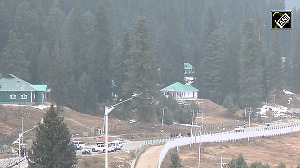A laboured enumeration of specifics alone cannot do justice to United States President George W Bush's three-day visit.
Both on the positive side -- of giving a big boost to India-US relations and helping the strategic partnership take a quantum jump -- and on the negative side -- of stirring up the bitter opponents of US policies among the Leftists and Muslim groups -- Bush could only be said to have left a memorable imprint.
It is good for India since it too has the spotlight turned on it in the process of the head of State of the most powerful, affluent and influential nation coming all the way to pay respects to it, as it were.
None watching the various happenings displayed on television screens would have failed to notice how the leaders of the two democracies hit it off with each other, in the true style of long-time buddies.
Simply Bushed
Even a sceptic, such as I was, has to admit that within the span of a short visit, Bush managed to stage a veritable public relations coup, overshadowing -- by his zestful courting of India and its people -- even the shrill countrywide demonstrations against him.
It was clear that he had developed a genuine admiration for the outstanding achievements of the billion-strong democracy and the spirit of tolerance and harmony distinguishing the bewilderingly pluralistic society.
What Bush told B-school students
On all accounts, he seems to have been determined not to go back without pulling off the one stunner -- the civil nuclear compact -- that, more than any other, would be a feather in his cap.
Reportedly, the talks at the official level over the separation of India's civilian and military nuclear facilities were on the rocks right up to the moment of the meeting of the two leaders on the morning of March 2, and it was only his overruling of all the objections raised from the US side that made it sail through in the nick of time.
By any token, the coming together of two great democracies on a matter that both hold to be of great significance -- not only for their energy security but also for the optimum utilisation the world's energy resources -- is a landmark event.
Let us give credit where credit is due: After many false starts, India has worked out a clear demarcation between civilian and military nuclear facilities, keeping the fast breeder reactors and research establishments out of the purview of the accord, and conveying its willingness to comply with any mutually acceptable framework of 'India-specific' safeguards following discussions between India and the International Atomic Energy Agency.
The Singh-Bush Joint Statement
The US, on its part, has given its approval to India's separation plan, and undertaken to make available supply of nuclear fuel for as long as required, promising to place before the US Congress and the Nuclear Suppliers Group proposals to amend the laws and the regulations facilitating the smooth implementation of the agreement.
According to the media briefing by US Under Secretary of State Nicholas Burns, India will be free to make future additions to its fast breeders and military facilities, and 'could build reactors (to) service (its) nuclear weapons industry.'
There will also apparently be no fettering of India's judgment on the nuclear deterrence it needs to take care of its security concerns.
Indian Minister of Commerce Kamal Nath has claimed that 'the deal would eventually translate into generation of 60,000 megawatts of power which would put India on to a different platform altogether.'
On the face of it, his figure -- equalling the total estimated availability from hydropower -- is high-pitched.
But it is futile at this stage, when everything has been sewn up, to harp on the question of whether India needed to go to such great lengths when the thorium technology already within the reach of the Indian scientists may soon make any reliance on outside source of nuclear fuel supply redundant.
A brave new world
There is no need to go into whether the real motivation for the US is to draw India into the vortex of its own global power play, especially with the aim of containing China.
That Leviathan of South Asia is awake enough to take care of itself, and India too, functioning within the checks and balances of democracy, can be expected to keep its eyes wide open against any machinations to make it a stooge of some other country's stratagems.
On the whole, the deal stands out as the harbinger of a new era of trust and faith between an established world power and a putative one.
Prime Minister Dr Manmohan Singh, not given to high-flown expressions, told President Bush at the media conference that they had 'made history.' President Bush too exulted over the achievement.
Eventually it is to be hoped that the deal will secure the approval of the US Congress, and India will be able to arrive at a standing arrangement with the IAEA and the NSG on the kind of safeguards and guidelines that would be in tune with its national interest.
The absence of any precedent makes the task of hammering them out to suit the status of India, which does not quite fit into the known definition of either a nuclear weapons State or a non-nuclear entity, and which has stayed out of the Non Proliferation and Comprehensive Test Ban Treaties enormously complicated.
Notably, IAEA's mandatory requirements that safeguards should extend to all the nuclear materials -- both those which are weapons-usable and those which require additional processing in order to become weapons-usable -- on the territory of the country concerned, and that nuclear material should not be diverted from peaceful applications to nuclear weapons or other explosive devices will cause problems for India.





